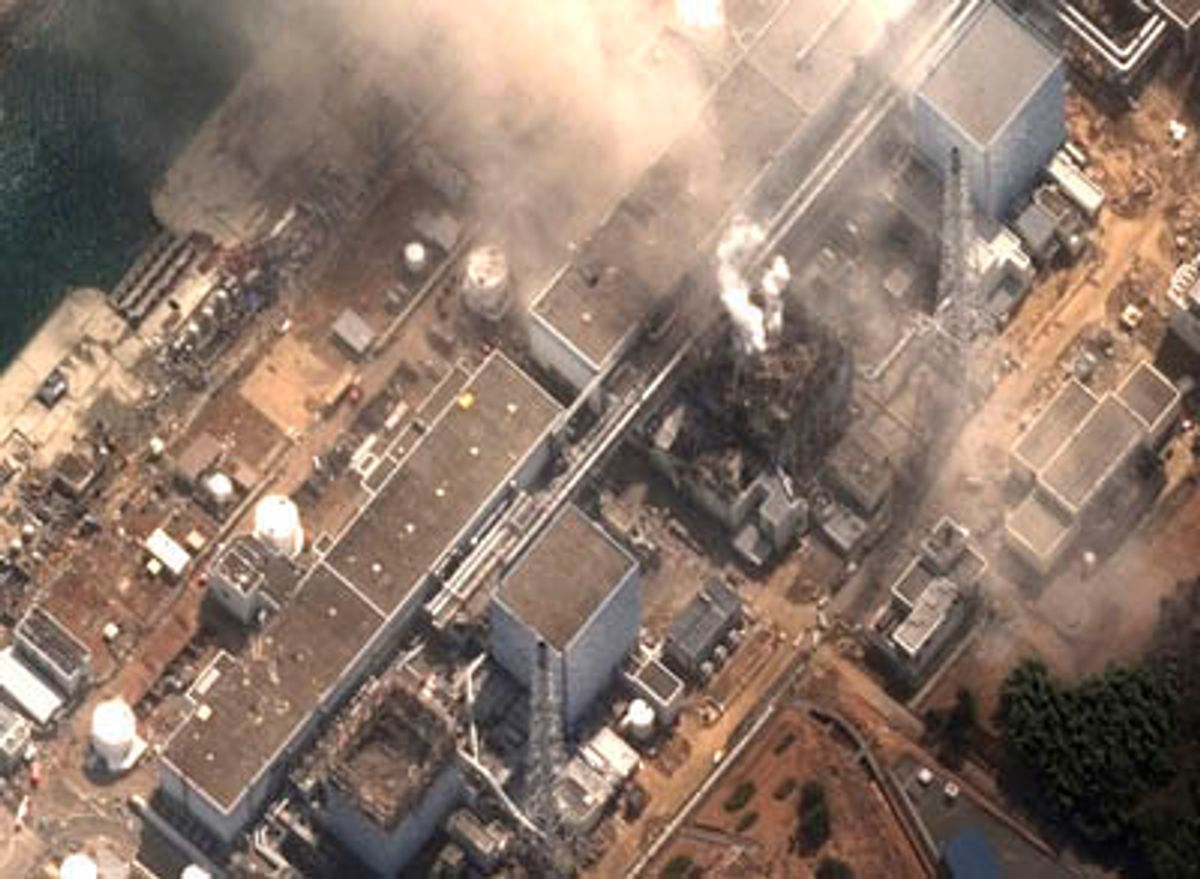Editor's Note: John Boyd is an IEEE Spectrum contributor reporting from Kawasaki, Japan. This is part of IEEE Spectrum's ongoing coverage of Japan's earthquake and nuclear emergency. For more details on how Fukushima Dai-1's nuclear reactors work and what has gone wrong so far, see our explainer and our timeline.
More seawater pumping operations into the reactor buildings of Fukushima Dai-1 Nuclear Power Plant damaged in the 11 March earthquake were planned for the day. Power company repair crews, after bringing electricity to the site from an outside electricity grid line, were also busy checking pumps, instruments, and control panels at some of the damaged reactor buildings. But all these operations had to be changed or halted in the afternoon when it was learned that pressure was rising in the No. 3 reactor container vessel.
The fire-fighting operation to jet seawater into the No. 3 reactor spent fuel storage pool of the Fukushima Dai-1 Nuclear Power station that began around 2 p.m. Saturday afternoon continued for more than 13 hours, finally ending at 3:40 a.m. Sunday morning. The aim was to replace water that evaporated after power was lost due to the earthquake and tsunami. Experts on NHK, Japan’s national broadcaster, said more than 2000 tons of water had been used.
This was followed Sunday morning by a Japan Self-defense Force operation using fire trucks to pump seawater into the spent fuel storage pool of the No. 4 reactor building which had also lost water after the power loss and when fires broke out there last Tuesday and Wednesday destroying the roof. It was reported 80 tons of water was aimed into the building.
Speaking on television, Hidehiko Nishiyama, deputy director general of the Nuclear and Industrial Safety Agency, said in a morning bulletin that radiation levels had been measured at 500 meters from the No. 3 reactor building. At 8 a.m. this morning the level was 2625 microsieverts compared to 3443 microsieverts measured at 2 p.m. yesterday. An NHK expert said this represented a drop of over 800 microsieverts, but a larger drop was expected, given the amount of water poured into the No. 3 reactor building.
One hundred millisieverts had been the maximum amount of radiation a worker should be exposed to during one stint. But Saturday morning a company official said that it had now raised the maximum level to 150 millisieverts because of the emergency.
TEPCO provided some positive news when it reported temperatures had gone down in the spent fuel storage pools of the No. 5 and No. 6 reactors after repair crews managed to restore some power there yesterday. The temperature of the storage pool water in the No. 6 reactor building at 3 a.m Sunday morning was 52 C, down from 67.5 Cat 11 p.m. on Saturday. Similarly, the water temperature in the No. 5 reactor storage pool measured 43.1 C at 3. a.m Sunday morning, compared to 68.8 C at 5 a.m. on Saturday.
TEPCO had previously been using a temporary diesel generator to supply power to both storage pools, but the generator was unable to cope when the water temperatures began rising. The company says it is now working to fully restore the cooling systems to both pools.
The fire fighting crews sent from Tokyo were due to continue their water pumping operation in the afternoon. But plans changed when Hidehiko Nishiyama, deputy director general of the Nuclear and Industrial Safety Agency, said in a televised press conference Sunday afternoon, that “pressure was rising in the containment vessel” of the No. 3 reactor.
Though Nishiyama gave no reason for the cause of the rising pressure or any pressure figures, he said it had been decided to release air from the reactor’s pressure pool, which regulates pressure in the vessel. But if that didn’t work, he said the only alternative would be to open a valve in the containment vessel to the atmosphere, an operation that would also release radioactive materials into the air. He added that all work on water pumping and restoring power to the reactors would have to be suspended while this took place.
Around 4 p.m. TEPCO made it known that temperature in the No. 3 reactor containment vessel had decreased and was stabilizing. Though no details were given for the decrease, the pressure went down before venting had to take place. In a later televised press conference Chief Cabinet Secretary Yukio Edano said that efforts to stabilize the No. 3 reactor containment vessel had been effective so far but the outcome remained “unreadable.”
Later, NHK reported that the Japan Self-Defense Force had begun water-pumping operations into the No. 4 reactor building at 6:20 p.m., while fire fighters were preparing a similar operation for the No. 3 reactor.
Photo: TEPCO





